Abstract
To investigate whether the occurrence of chronic gastritis (and Helicobacter pylori acquisition) has changed in Finland in the past 15 years, the prevalence rates of chronic gastritis in biopsy specimens in consecutive series of outpatients (aged 20 or more) who had undergone diagnostic upper gastrointestinal endoscopy in 1977 (702 patients), 1985 (1309 patients), or 1992 (1447 patients) were compared. The prevalences of gastritis in these series were also compared with that in a random sample (438 subjects) of people who underwent endoscopy in 1974-76. It seemed that the prevalence of gastritis was significantly lower in the outpatients in 1992 than in the random endoscopy sample in 1974-76. The reduction was most noticeable in young age groups (20-49 years) in which the decline was 38% (drop from 66% to 41%). In addition, it seemed that the prevalence of gastritis was very dissimilar in different birth cohorts. The prevalence was high (70-80%) in 1977, 1985, and 1992 in the cohorts born at the beginning of the century and lower (40-50%) in those born during later decades. The prevalence rates had remained unchanged in the same cohorts over the 15 years (from 1977 to 1992) suggesting that the people had mainly been infected with H pylori and contracted gastritis before the age of 20. In conclusion, gastritis is a cohort phenomenon and its prevalence has fallen in Finland in the last 15 years. This decrease is caused by a decline of the rate of H pylori acquisition in birth cohorts, particularly in childhood and adolescence (below age of 20).
Full text
PDF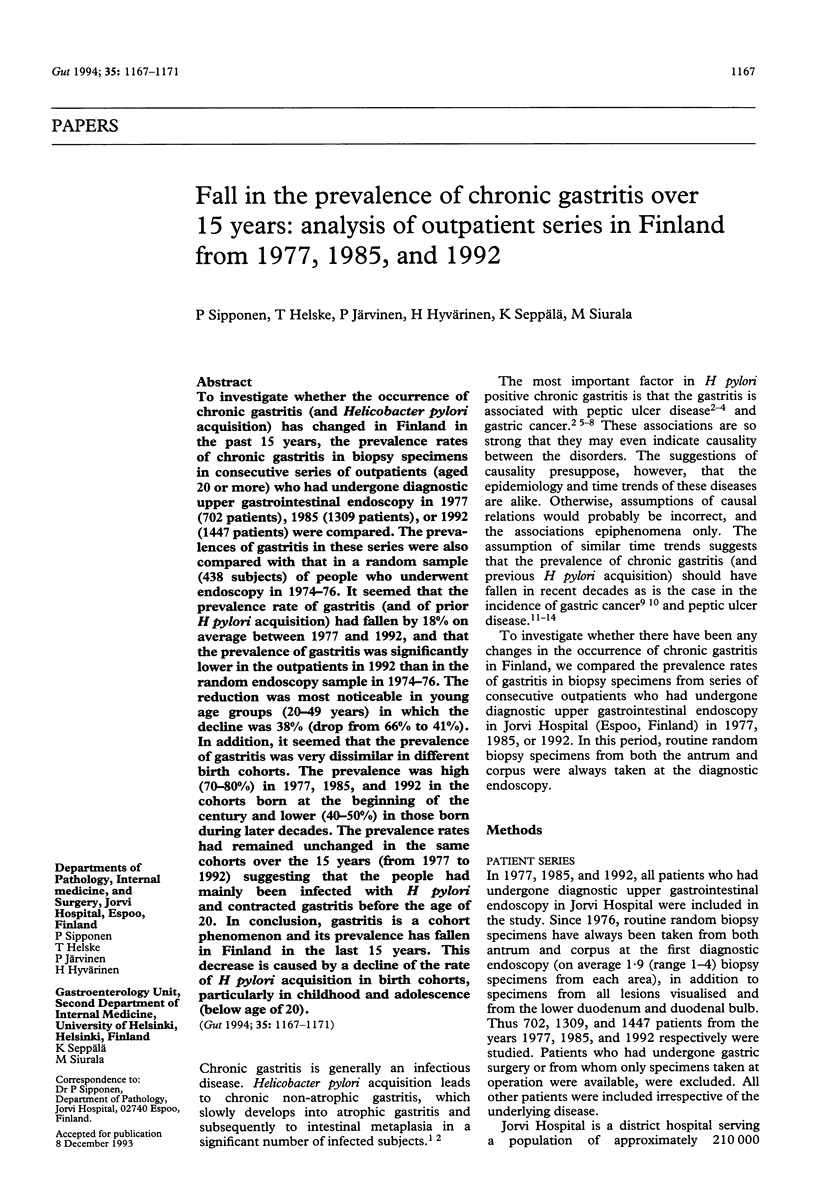
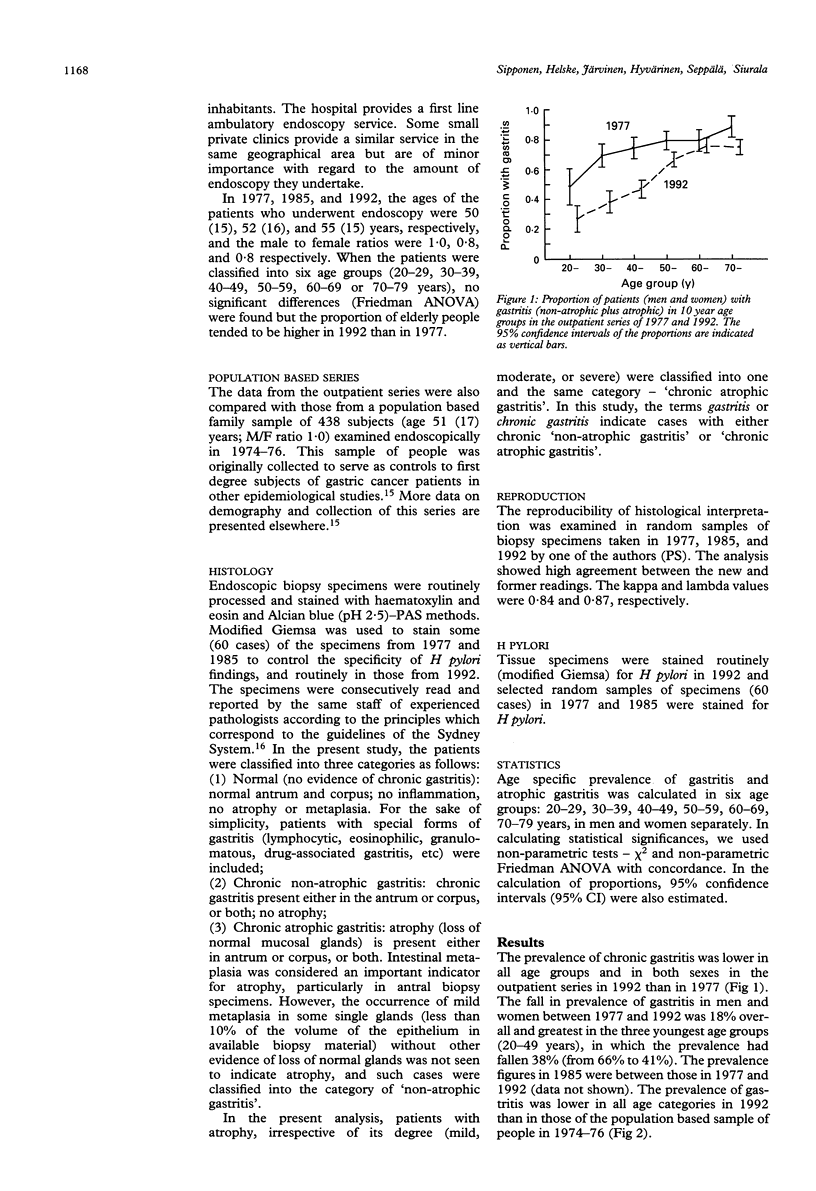
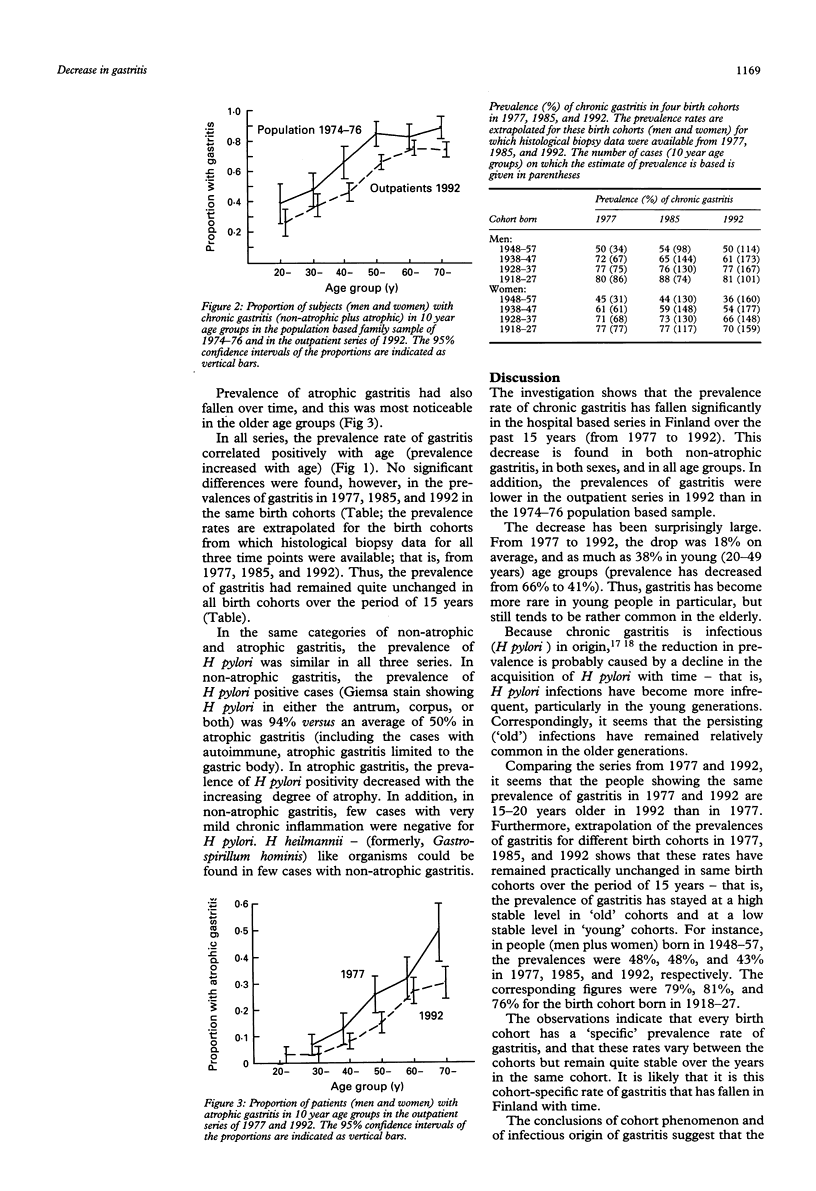
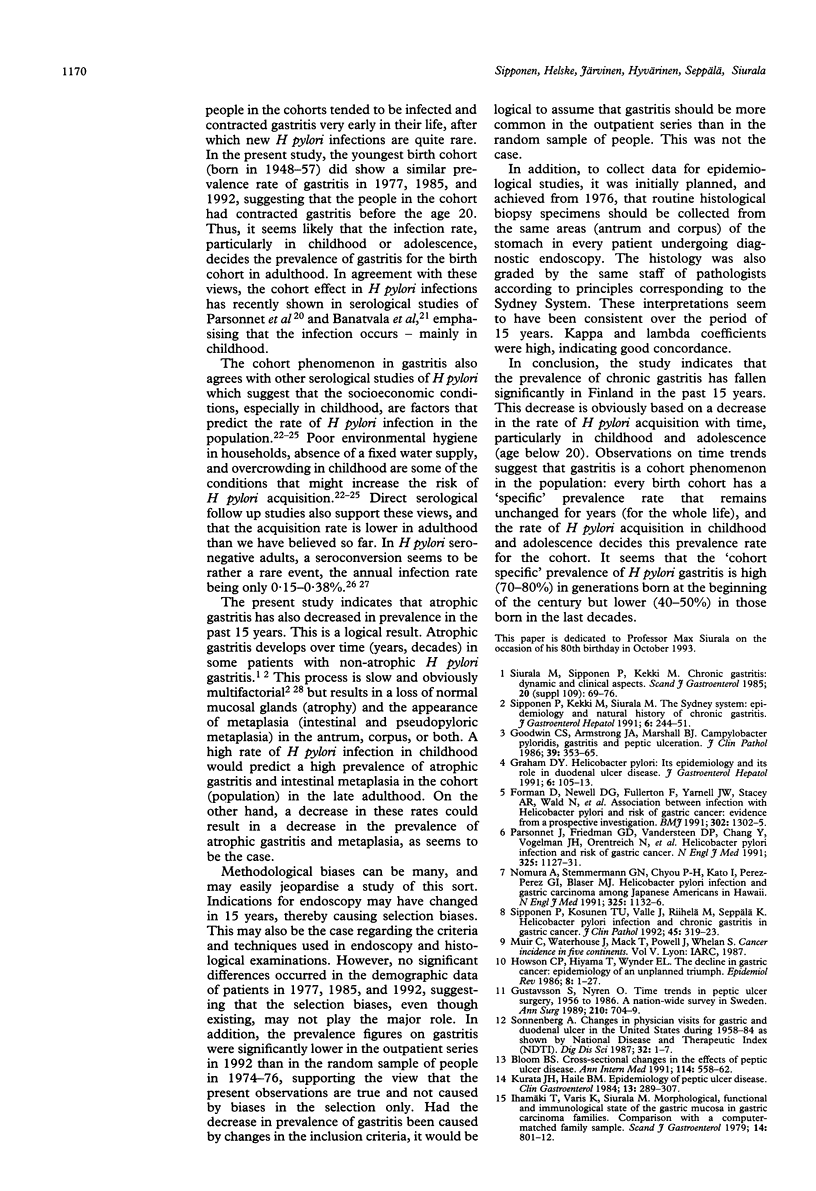
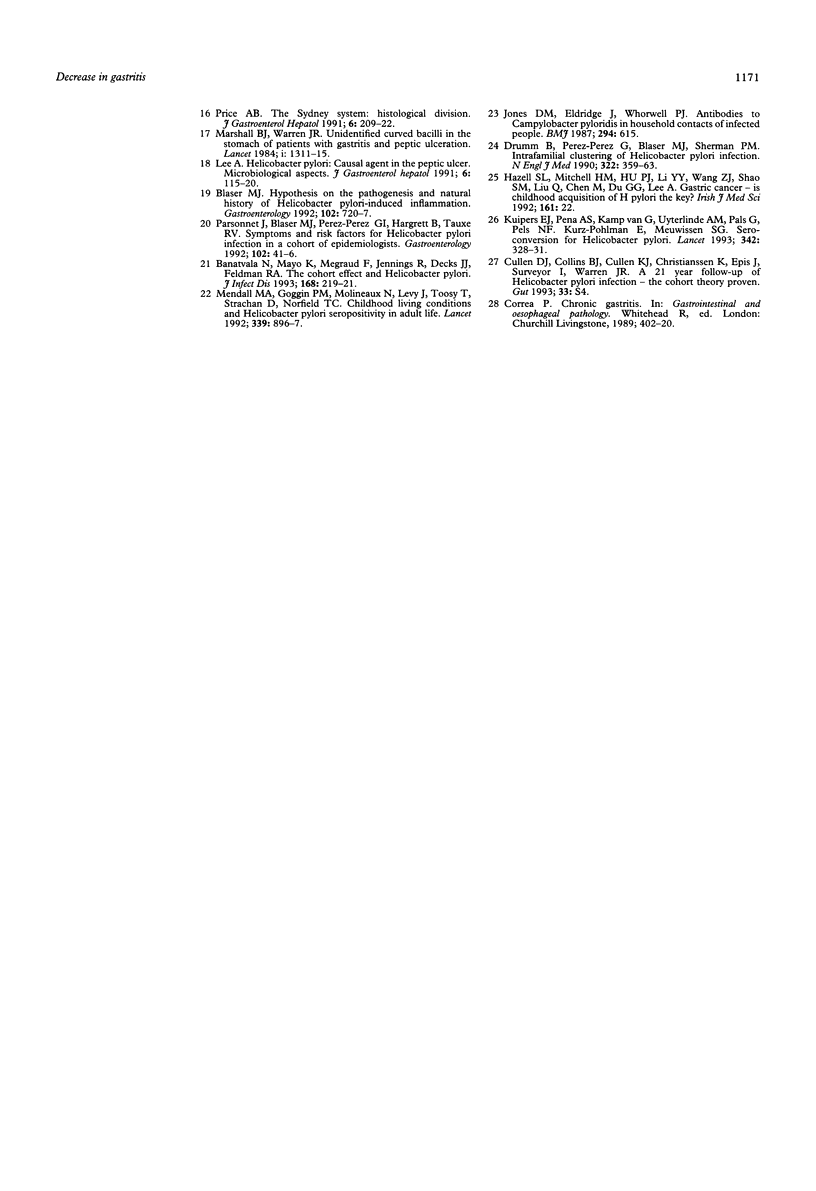
Selected References
These references are in PubMed. This may not be the complete list of references from this article.
- Banatvala N., Mayo K., Megraud F., Jennings R., Deeks J. J., Feldman R. A. The cohort effect and Helicobacter pylori. J Infect Dis. 1993 Jul;168(1):219–221. doi: 10.1093/infdis/168.1.219. [DOI] [PubMed] [Google Scholar]
- Blaser M. J. Hypotheses on the pathogenesis and natural history of Helicobacter pylori-induced inflammation. Gastroenterology. 1992 Feb;102(2):720–727. doi: 10.1016/0016-5085(92)90126-j. [DOI] [PubMed] [Google Scholar]
- Bloom B. S. Cross-national changes in the effects of peptic ulcer disease. Ann Intern Med. 1991 Apr 1;114(7):558–562. doi: 10.7326/0003-4819-114-7-558. [DOI] [PubMed] [Google Scholar]
- Drumm B., Perez-Perez G. I., Blaser M. J., Sherman P. M. Intrafamilial clustering of Helicobacter pylori infection. N Engl J Med. 1990 Feb 8;322(6):359–363. doi: 10.1056/NEJM199002083220603. [DOI] [PubMed] [Google Scholar]
- Goodwin C. S., Armstrong J. A., Marshall B. J. Campylobacter pyloridis, gastritis, and peptic ulceration. J Clin Pathol. 1986 Apr;39(4):353–365. doi: 10.1136/jcp.39.4.353. [DOI] [PMC free article] [PubMed] [Google Scholar]
- Graham D. Y. Helicobacter pylori: its epidemiology and its role in duodenal ulcer disease. J Gastroenterol Hepatol. 1991 Mar-Apr;6(2):105–113. doi: 10.1111/j.1440-1746.1991.tb01448.x. [DOI] [PubMed] [Google Scholar]
- Gustavsson S., Nyrén O. Time trends in peptic ulcer surgery, 1956 to 1986. A nation-wide survey in Sweden. Ann Surg. 1989 Dec;210(6):704–709. doi: 10.1097/00000658-198912000-00003. [DOI] [PMC free article] [PubMed] [Google Scholar]
- Howson C. P., Hiyama T., Wynder E. L. The decline in gastric cancer: epidemiology of an unplanned triumph. Epidemiol Rev. 1986;8:1–27. doi: 10.1093/oxfordjournals.epirev.a036288. [DOI] [PubMed] [Google Scholar]
- Ihamäki T., Varis K., Siurala M. Morphological, functional and immunological state of the gastric mucosa in gastric carcinoma families. Comparison with a computer-matched family sample. Scand J Gastroenterol. 1979;14(7):801–812. doi: 10.3109/00365527909181408. [DOI] [PubMed] [Google Scholar]
- Jones D. M., Eldridge J., Whorwell P. J. Antibodies to Campylobacter pyloridis in household contacts of infected patients. Br Med J (Clin Res Ed) 1987 Mar 7;294(6572):615–615. doi: 10.1136/bmj.294.6572.615-a. [DOI] [PMC free article] [PubMed] [Google Scholar]
- Kuipers E. J., Peña A. S., van Kamp G., Uyterlinde A. M., Pals G., Pels N. F., Kurz-Pohlmann E., Meuwissen S. G. Seroconversion for Helicobacter pylori. Lancet. 1993 Aug 7;342(8867):328–331. doi: 10.1016/0140-6736(93)91473-y. [DOI] [PubMed] [Google Scholar]
- Kurata J. H., Haile B. M. Epidemiology of peptic ulcer disease. Clin Gastroenterol. 1984 May;13(2):289–307. [PubMed] [Google Scholar]
- Marshall B. J., Warren J. R. Unidentified curved bacilli in the stomach of patients with gastritis and peptic ulceration. Lancet. 1984 Jun 16;1(8390):1311–1315. doi: 10.1016/s0140-6736(84)91816-6. [DOI] [PubMed] [Google Scholar]
- Mendall M. A., Goggin P. M., Molineaux N., Levy J., Toosy T., Strachan D., Northfield T. C. Childhood living conditions and Helicobacter pylori seropositivity in adult life. Lancet. 1992 Apr 11;339(8798):896–897. doi: 10.1016/0140-6736(92)90931-r. [DOI] [PubMed] [Google Scholar]
- Parsonnet J., Blaser M. J., Perez-Perez G. I., Hargrett-Bean N., Tauxe R. V. Symptoms and risk factors of Helicobacter pylori infection in a cohort of epidemiologists. Gastroenterology. 1992 Jan;102(1):41–46. doi: 10.1016/0016-5085(92)91782-y. [DOI] [PubMed] [Google Scholar]
- Price A. B. The Sydney System: histological division. J Gastroenterol Hepatol. 1991 May-Jun;6(3):209–222. doi: 10.1111/j.1440-1746.1991.tb01468.x. [DOI] [PubMed] [Google Scholar]
- Sipponen P., Kekki M., Siurala M. The Sydney System: epidemiology and natural history of chronic gastritis. J Gastroenterol Hepatol. 1991 May-Jun;6(3):244–251. doi: 10.1111/j.1440-1746.1991.tb01472.x. [DOI] [PubMed] [Google Scholar]
- Sipponen P., Kosunen T. U., Valle J., Riihelä M., Seppälä K. Helicobacter pylori infection and chronic gastritis in gastric cancer. J Clin Pathol. 1992 Apr;45(4):319–323. doi: 10.1136/jcp.45.4.319. [DOI] [PMC free article] [PubMed] [Google Scholar]
- Siurala M., Sipponen P., Kekki M. Chronic gastritis: dynamic and clinical aspects. Scand J Gastroenterol Suppl. 1985;109:69–76. doi: 10.3109/00365528509103939. [DOI] [PubMed] [Google Scholar]
- Sonnenberg A. Changes in physician visits for gastric and duodenal ulcer in the United States during 1958-1984 as shown by National Disease and Therapeutic Index (NDTI). Dig Dis Sci. 1987 Jan;32(1):1–7. doi: 10.1007/BF01296680. [DOI] [PubMed] [Google Scholar]


